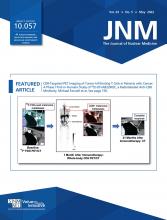As an indication of how quickly the field of nuclear medicine is advancing, the Appropriate Use Criteria (AUC) for Prostate-Specific Membrane Antigen (PSMA) PET document has been updated (1). This is due to the recent U.S. Food and Drug Administration (FDA) approval of 177Lu-PSMA-617 (Pluvicto, 177Lu-vipivotide tetraxetan; Novartis [Basel, Switzerland]/Advanced Accelerator Applications USA, Inc. [Millburn, NJ]) radiopharmaceutical therapy (RPT). Previously the AUC had scored the indication for a posttreatment prostate-specific antigen (PSA) rise in the metastatic castration-resistant prostate cancer (mCRPC) setting as “may be appropriate.” This was because no available PSMA-targeted therapies would benefit from imaging using PSMA PET. With the approval of PSMA RPT, the PSMA PET AUC Working Group has split this indication into 2 distinct indications (see supplemental materials, available at http://ow.ly/ABfv30sh3uO). The first is “Posttreatment PSA rise in the mCRPC setting in a patient not being considered for PSMA-targeted radiopharmaceutical therapy,” which was again scored as “may be appropriate,” because the clinical value of improved tumor localization in grossly metastatic disease is not clear in patients who are not being considered as candidates for PSMA RPT. The second indication is “Evaluation of eligibility for patients being considered for PSMA-targeted radiopharmaceutical therapy,” which was scored as “appropriate” given the availability of a PSMA-targeted therapy.
An important point is that the AUC Working Group agreed that both 18F-DCFPyL (Pylarify, 18F-piflufolastat; Lantheus [Billerica, MA]) and 68Ga-PSMA-11 (Illuccix and Locametz, 68Ga-gozetotide; Telix Pharmaceuticals Ltd. [Melbourne, Australia], and Novartis/AAA, respectively) should be considered equivalent for selection of patients for treatment with 177Lu-PSMA-617. In the prescribing information for 177Lu-PSMA-617, the FDA recommended selection of “patients for treatment using Locametz or an approved PSMA-11 imaging agent based on PSMA expression in tumors.” However, given the near equivalency of 68Ga-PSMA-11 and 18F-DCFPyL, either of these radiotracers can be used for patient selection.
Another consideration for patient selection is what cutoff should make a patient eligible. Two randomized trials have evaluated 177Lu-PSMA-617 therapy: the VISION and TheraP trials. Optimal PSMA PET criteria for patient selection are not yet well established. In the VISION trial, eligibility required uptake in disease greater than that in the liver, and no measurable disease with uptake less than that in the liver (2). Eligibility in the TheraP study required an SUV ≥20 at 1 site of disease, an SUV ≥10 at measurable soft tissue sites, and no 18F-FDG–positive PSMA-negative sites of disease (3). It should be noted that, in general, the higher the uptake on PSMA PET, the better patients respond to treatment (4,5). PSMA PET is not only a prognostic biomarker but was shown to be predictive in the TheraP trial, with patients who had an SUVmean ≥10 having a higher likelihood of PSA response compared to chemotherapy (cabazitaxel) (6). Although the decision in the VISION trial was binary, uptake may be used to help weigh various treatment options. The debate as to whether 18F-FDG PET/CT should also be used to screen patients prior to PSMA RPT is outside of the scope of the PSMA PET AUC, although 18F-FDG PET may provide additional value in identifying 18F-FDG–positive/PSMA-negative sites of disease (3).
PSMA PET plays a significant role in the appropriate selection of patients for PSMA RPT. With the approval and availability of 2 PSMA PET agents, this imaging study should be widely available. Overall, these 2 imaging agents are considered equivalent for patient selection.
- © 2022 by the Society of Nuclear Medicine and Molecular Imaging.







